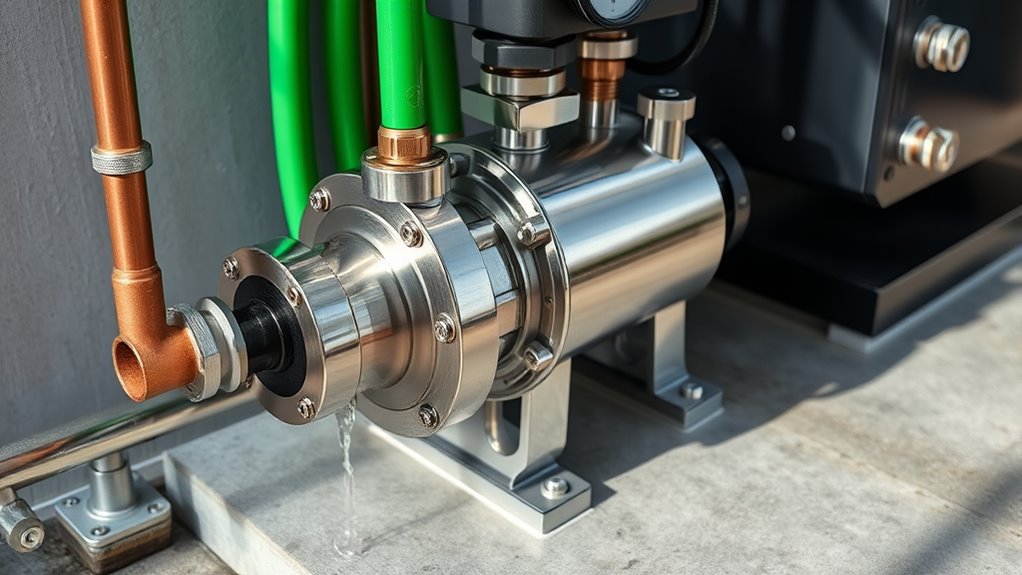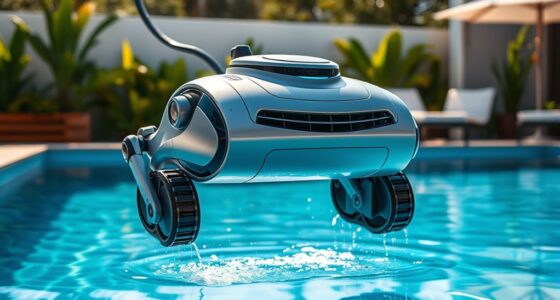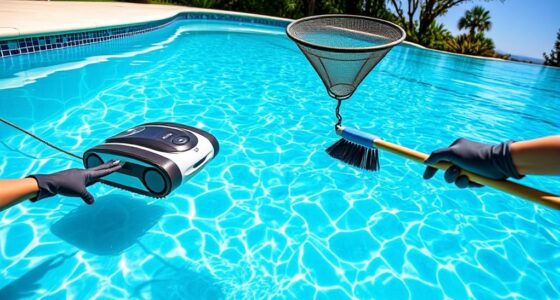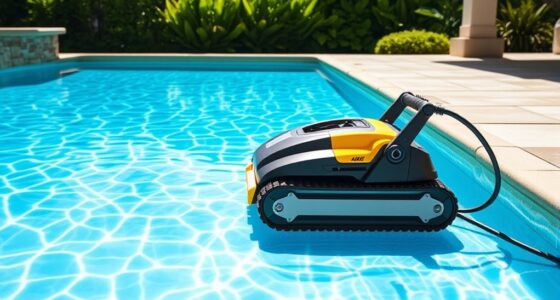If you notice weak or inconsistent water pressure, especially when using multiple fixtures or in multi-story homes, a booster pump could help. It’s essential if your water source is a well or located far from your house, or if pressure drops as elevation rises. Installing one can improve flow, reduce strain on plumbing, and boost your everyday comfort. To find out if a booster pump fits your needs, explore more options below.
Key Takeaways
- Low water pressure that drops during peak usage indicates a booster pump may be needed.
- Multi-story buildings often require boosters to maintain consistent water flow across all floors.
- If your household relies on well water or has inconsistent pressure, a booster pump can improve flow.
- Uneven water pressure or weak flow in faucets and appliances suggests installing a booster pump might help.
- Regularly checking your water pressure can help determine if a booster pump will enhance your system’s performance.
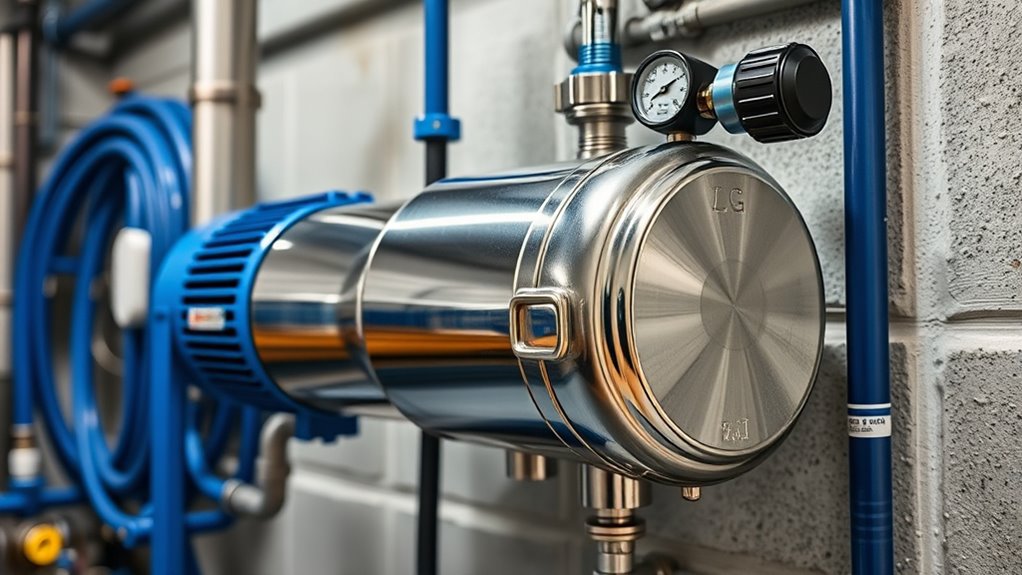
Have you ever wondered how water reaches higher floors or maintains consistent pressure in your plumbing system? If you live in a multi-story building or have a property with distant water sources, chances are you’ve experienced fluctuations in water pressure or inadequate flow. These issues often stem from the limitations of your existing plumbing setup, especially if the water pressure drops as you go higher or when multiple fixtures are in use. That’s where a booster pump comes into play. It’s designed to increase water pressure and ensure a steady flow, making your daily routines smoother and more reliable.
Boost water pressure in multi-story buildings for consistent flow and better daily comfort.
When considering a booster pump, the first thing to evaluate is your current water pressure. If your water pressure is consistently low, or if it drops markedly when multiple faucets or appliances are running, a booster pump could be the solution. These pumps are typically installed at strategic points in your plumbing system—often near the main water line or at specific outlets—to boost pressure locally or throughout the entire house. Proper pump installation is critical; it ensures the system functions efficiently and safely. An improperly installed booster pump can lead to issues like water hammer, leaks, or even damage to your pipes, so it’s best to rely on a professional if you’re unsure.
The process of pump installation involves connecting the pump to your existing water line, ensuring it’s secured and sealed correctly. It’s important to match the pump’s capacity to your household’s needs—too small, and it won’t solve your water pressure problems; too large, and you might waste energy or cause unnecessary wear on your plumbing. Once installed, the booster pump activates automatically when water demand increases, maintaining a consistent pressure regardless of how many fixtures are in use. This automation makes your water system more efficient, reducing the frustration of weak or inconsistent flow. Additionally, selecting a pump with the appropriate pressure capacity can help optimize performance and longevity.
Furthermore, advancements in AI-driven solutions are beginning to influence the design and efficiency of water systems, including booster pumps, making them smarter and more adaptable to varying demand. A booster pump is especially beneficial if you notice that water pressure is uneven, or if your household relies on a well or alternative water source. It can considerably improve your experience by delivering stronger, more reliable water flow to showers, faucets, and appliances. Additionally, it can extend the lifespan of your plumbing by reducing the strain caused by pressure fluctuations. Regularly checking your water pressure can help you determine if you need a booster pump, as low water pressure is a common reason for installation. Proper maintenance and system diagnostics can further enhance the efficiency of your water setup.
In some cases, water pressure regulators can be used in conjunction with booster pumps to finely tune the system and prevent excessive pressure that could damage pipes. While installing a booster pump involves some upfront investment and professional help, the benefits of steady water pressure and enhanced comfort often outweigh these costs. Proper pump installation ensures you get the maximum benefit, providing you with consistent, reliable water flow. It’s a practical solution designed to address common water pressure issues, making your home more comfortable and your plumbing more efficient.
Frequently Asked Questions
How Long Does a Booster Pump Typically Last?
A booster pump usually lasts between 5 to 10 years, depending on its pump lifespan and how well you uphold it. Regular maintenance, like checking for leaks and cleaning filters, can extend its life. You should also monitor its performance and address any unusual noises or pressure drops promptly. Proper care ensures your pump runs efficiently longer, saving you money and preventing unexpected breakdowns.
Can a Booster Pump Operate Continuously?
A booster pump can operate continually if it’s designed for that purpose, but you should check the manufacturer’s guidelines. Continuous operation requires proper pump maintenance to prevent overheating and wear. Regularly inspect for leaks, listen for unusual noises, and ensure the system is clean. If you plan to run it nonstop, consider a pump rated for continuous use to extend its lifespan and maintain peak performance.
What Are Signs of a Failing Booster Pump?
When your booster pump starts failing, you’ll notice signs like decreasing water pressure, making showers and faucets less effective. You might also hear unusual pump noise, such as grinding or knocking sounds, indicating trouble. If the pump runs constantly without boosting pressure or struggles to turn on, these are red flags. Addressing these issues early can prevent complete breakdown and ensure your water system stays dependable.
Are Booster Pumps Energy-Efficient?
Booster pumps can be quite energy-efficient, especially if you choose models with high pump efficiency. They help optimize energy consumption by maintaining consistent water pressure without overworking your system. When selected wisely, modern booster pumps use less power and reduce energy costs. So, investing in an efficient pump not only improves water pressure but also saves you money in the long run, making it a smart and eco-friendly choice.
How Much Does Installing a Booster Pump Cost?
Imagine your water flowing smoothly, no more sputtering or low pressure. Installing a booster pump costs vary based on factors like pump size, brand, and installation complexity. The process involves connecting the pump to your existing system, which typically takes a few hours. Expect costs ranging from $300 to $1,200, including parts and labor. Considering these factors helps you plan better for a steady, reliable water supply.
Conclusion
If your home’s water pressure feels weak or inconsistent, a booster pump could be the solution you require. Imagine waking up to a shower with strong, steady water flow every morning—no more waiting or cold surprises. For example, homeowners in hilly areas often install booster pumps to ensure reliable pressure throughout their house. Consider your own water needs and system setup; a booster pump might be just what you need to improve your daily water experience.
